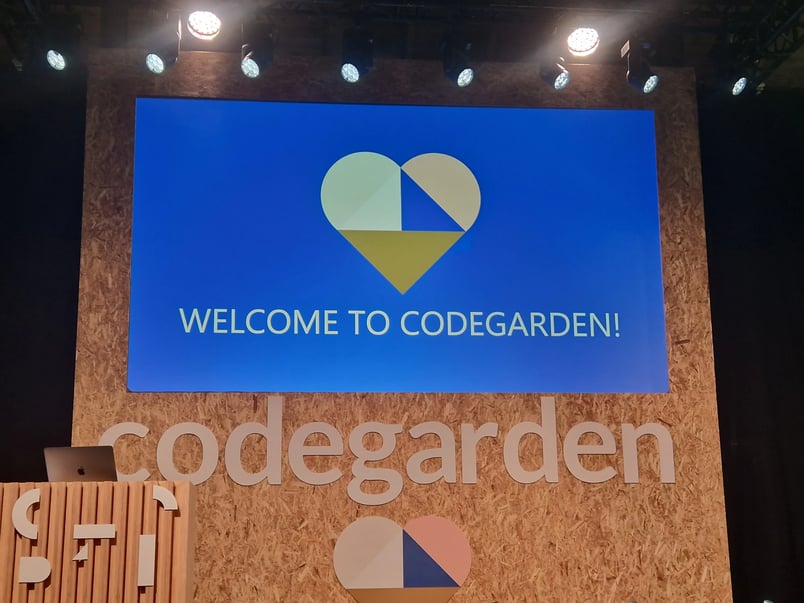
What does the future look like for Umbraco? Key takeaways from Codegarden 2023
From June 14-16, 2023, we sent our Umbraco developer and MVP to Odense to participate in Umbraco Codegarden - Umbraco's annual event where developers are invited for knowledge sharing and networking. The days were filled with valuable insights - we have gathered the most important key takeaways for you.
Although a couple of weeks have passed, the confetti has fallen, the applause has subsided, and everyday life has returned to normal for MCB's Umbraco team, we are still thrilled about all the new insights, engaging dialogues, and exciting events that took place when we participated in Codegarden 2023. It was three days of full throttle, and if we weren't already in love with Umbraco, we definitely are now!
We sent our MVP (and now reappointed MVP for 2023), Bjarne Fyrstenborg, off to Odense, so he could absorb as much knowledge and inspiration as possible over three days. He has returned with a full bag of goodies, which we have distilled into 5 important key takeaways that outline the future for Umbraco.
And of course, Bjarne himself has some thoughts on the future of Umbraco. You can find them below.
5 takeaways from Codegarden 2023
1. Vendr is now Umbraco Commerce
In 2023, Umbraco announced the acquisition of the company behind Vendr - an e-commerce module that enables running webshops on the Umbraco CMS. Vendr allows you to create and manage your online store directly from Umbraco's CMS interface. Like Umbraco, Vendr is built on .NET technology and offers a range of features that make it easy to manage your e-commerce business, including product management, customer administration, payment gateway integration, and more.
With this announcement, Umbraco took a big step towards becoming a better e-commerce solution, and now, another step has been taken.
At Codegarden, it was revealed that Vendr has transformed into Umbraco Commerce.
Initially, Umbraco Commerce will contain the same functionalities as Vendr. Commerce is simply the rebranding of Vendr. Commerce will continue to function as a separate module for Umbraco, integrating with Umbraco CMS. However, there will be an increased focus on developing new features, better compatibility with add-ons like Umbraco Deploy, and improved system support.
The future will bring better opportunities for integrating with third-party services, either as smaller apps/packages or through necessary extension points, allowing developers to integrate with third-party services.
Furthermore, there will be ongoing development on the implementation of a shipping provider (similar to the concept of a payment provider). This involves configuring your provider or supplier, which can have one or more payment/delivery methods. The idea is to integrate with shipping services such as Shipmondo or Webshipper, where different providers like PostNord, GLS, DAO, etc., can be configured.
Adding e-commerce functionality to an existing Umbraco website will become easier with effortless product setup, seamless payment flow, and efficient order management. Everything can be customized using open design functionalities, allowing you to create a personalized shopping experience on your new webshop.
Umbraco is jumping on this trend at the right time because e-commerce provides limitless possibilities for growth, expansion, and scaling.
2. Backoffice has been rewritten and is now based on WebComponents
Backoffice' refers to what we commonly know as the 'Backend.' Backoffice serves multiple purposes in Umbraco. It is the control panel in an installation, and several workflows start here - especially when it comes to content editing, such as updating content, uploading images, and inserting various types of media elements.
Umbraco's Backoffice is constantly evolving. It has now reached new heights.
A completely new setup is being worked on, which has been rewritten from scratch, so that it will be based on WebComponents instead of AngularJS v1, which is currently in use. AngularJS v1 is outdated and no longer supported.
The new Backoffice will be faster and future-proof.
However, there are also new things coming for the Backoffice beyond just an upgrade. There has been significant development focused on extending Umbraco Commerce in the Backoffice, both in terms of user interface (UI) and APIs. This means that the Backoffice will support Umbraco Commerce and serve as a valuable addition to the strategy towards an e-commerce-driven platform.
The new Backoffice also emphasizes the ability to extend components and develop custom components. This means that in the future, it will be possible to customize the UI in the Backoffice, not only in add-on packages like Umbraco Commerce and Umbraco Forms but also in custom dashboards and through personalization of the Backoffice. Overall, this will provide a more consistent and streamlined UI.
The new Backoffice will be fully integrated in Umbraco 14.
3. Umbraco 12 has been launched with Content Delivery API / REST API
Later this year, Umbraco will support both .NET 8 and C# 12. This means significant improvements in terms of speed, performance, security, and better possibilities for extensions.
With Umbraco 12, which will be released on June 29, 2023, as a Short-Term Support (STS) release, a new content delivery API (REST API) will be made available. It can be activated straightforwardly, even if you don't have an API for querying content and media. It can be enabled to extract content and media, allowing you to retrieve Umbraco content items in JSON format.
Additionally, Entity Framework Core (EF Core), which handles data mapping between the database and classes, will be supported. Over time, EF Core will replace NPoco, which is currently used in significant parts of the codebase.
The goal is for this version to be the starting point towards a greater overlap with Umbraco Heartcore (the headless version of Umbraco). This means that it will be possible to operate a headless setup without relying on Umbraco Cloud.
At launch, Umbraco 12 will have undergone substantial improvements and adjustments. These include an upgrade of the image processing module to ImageSharp 3, which provides better performance and supports various functionalities. NPoco and MailKit have also been updated to their latest versions, while all other dependencies have received patch updates.
.NET 8 and C# 12 will be fully integrated in Umbraco 13.
4. Extensions and additional functionality for blocks
Umbraco has expressed that in the near future, there will be more intense work on blocks to ensure additional functionality and competitiveness.
One of the upcoming features will be the ability to use 'schedule publishing' at the block level, allowing you to determine when a specific block should become visible on your site or shop. Additionally, there will be work on variants and segmentation at the block level, as well as the possibility of having reusable blocks. Reusable blocks will function as global blocks that can be stored in a kind of 'Library section' and can be retrieved and reused across different page types. It will also be possible to convert a block into a global block.
The exact implementation of the above features has not yet been determined, but Umbraco and the community, who work with both small and large Umbraco solutions on a daily basis, are currently trying to define this.
All of these advancements make the Umbraco experience more user-friendly for both developers and content editors, and the features can also have a time-saving factor.
Furthermore, the future will bring additional developments of separate packages or add-ons that can be installed as needed. These will likely be driven by either the Umbraco community or Umbraco partners like MCB.
5. Increased efficiency with Umbraco Deploy and Umbraco Forms
Among Umbraco users, there is currently a growing interest in add-ons like Umbraco Deploy and Umbraco Forms. And it's for good reason. These are two particularly powerful features and tools that can not only improve your website administration but also enhance user interaction.
Umbraco Deploy is a feature used for managing and automatically transferring changes in the data structure across different environments and transferring content between environments. It is designed to streamline the development and deployment process, ensuring smooth and reliable updates of Umbraco-based websites.
Umbraco Deploy simplifies any deployment process, allowing developers to easily push changes between different environments while maintaining data integrity.
With Umbraco Deploy, you get a deployment engine maintained and supported by Umbraco HQ. Based on thousands of implementations and content transfers in Umbraco Cloud, you get a powerful and extensively tested feature that remains compatible with Umbraco.
Umbraco Forms is a tool that enables you to build forms of all shapes and sizes and place them on your Umbraco websites. It provides a user-friendly form builder that allows you to create interactive and customized forms, capturing valuable user data.
You can build forms using a wide range of elements such as multiple-choice, dropdowns, text areas, and checkboxes, and choose from various workflows that can control and automate actions when a form is submitted.
This is how we predict the future looks for Umbraco
Umbraco is making a big bet with Umbraco Commerce and taking on other major e-commerce systems such as Shopify and Magento. Therefore, we can expect to see extensions, new functionalities, and features taking Umbraco Commerce by storm.
Umbraco Commerce will be positioned as an attractive option for running e-commerce on Umbraco, partly because DXP (Digital Experience Platform) is also expected to be a significant part of the future strategy. A Digital Experience Platform should encompass opportunities for both e-commerce and working headless.
Umbraco Commerce will, therefore, support various forms of headless workflows.









